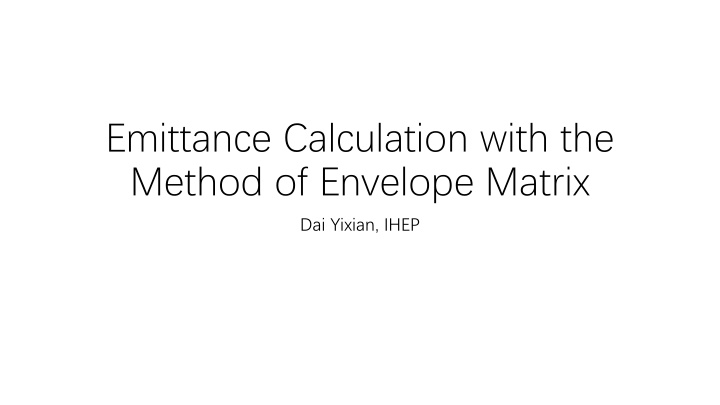
Emittance Calculation Methods in Particle Accelerators
Learn about emittance calculations in particle accelerators using envelope matrix, phase space descriptions, distribution modeling, quantum excitations, and more. Explore the concepts and mathematical formulas involved in understanding beam dynamics and emittance preservation.
Download Presentation

Please find below an Image/Link to download the presentation.
The content on the website is provided AS IS for your information and personal use only. It may not be sold, licensed, or shared on other websites without obtaining consent from the author. If you encounter any issues during the download, it is possible that the publisher has removed the file from their server.
You are allowed to download the files provided on this website for personal or commercial use, subject to the condition that they are used lawfully. All files are the property of their respective owners.
The content on the website is provided AS IS for your information and personal use only. It may not be sold, licensed, or shared on other websites without obtaining consent from the author.
E N D
Presentation Transcript
Emittance Calculation with the Method of Envelope Matrix Dai Yixian, IHEP
Coordinate The phase space is described by six variables (?,??,?,??,?,?) The momenta is the canonical conjugate ??=[??+ ???] ? ?0 ??=[??+ ???] ? ?0 ? =? ?0 ? ?0 Hamiltonian would be like: ? ?,??,?,??,?,? = ? ???/?0 Figure1:y is perpendicular to this plane 2 (?? ??? (1 + ? +? ??0)2 ?? ??? )2 ?0 ?0
Emittance Emittances : n conserved quantities which corresponds to the phase space volume. If there is a bunch of particles, the emittance can be calculated as following formula: ??= ?2?2 ??2 ?? ? ???? = 2?? Figure2: Emittance in phase space
Distribution Suppose the distribution of beam is Guassian. Therefore, the covariance matrix can fully describe the distribution. ??(?) = ??? ??(?) One-turn Map ? ??(? + ?) = ?(??? )?(??(?)) Equilibrium: ??(?) = ??(? + ?)
Quantum Excitation Only consider the zeroth and first order of the map ???. ???(??) = ?????+ ?? ??? :transfer matrix with damping ?? :the constant part with random effect. ?? vanishes, but ???? has non-zero values! 3 2???2?? ?? ?0 ?2(0, ?? ? 1 + ?,0,1)? ??? = 1 + ?,0, 2? Figure3: Particle emits a photon
Quantum Excitation Denote that ???(?) = ??(?)??(?) , What would ???(?) be like when it travels to s ? Since ??acts on the coordinates of the particle, it transfers just like coordinates. ?(?)???? ???(? + ??) = ?????(?)?? To get ??? of the ring, named as ???, we need an integral. ?(?2) ?(?,?1) ?(?,?2) ?+? ? ?(? )??? + ?,? ?? ? ? + ?,? ??(? )?? ???= ?(?1) ? ? = ? ?,?1? ?1???,?1 + ? ?,?2? ?1???,?2+ Figure4: How ??? calculates
Emittance Calculation Now we have a one-turn map for ?? ??? + ? = ? ??? ??+ ??? It s a linear equation and can be easily solved. ?2?2 ??2 ??= Note that it breaks down when there is coupling. Wolski s approach is more general: the eigenvalues of ?.
Ohmi, Kazuhito, Kohji Hirata, and Katsunobu Oide. "From the beam-envelope matrix to synchrotron-radiation integrals." Physical Review E 49.1 (1994): 751. Wolski, Andrzej. Beam dynamics in high energy particle accelerators. 2014.
